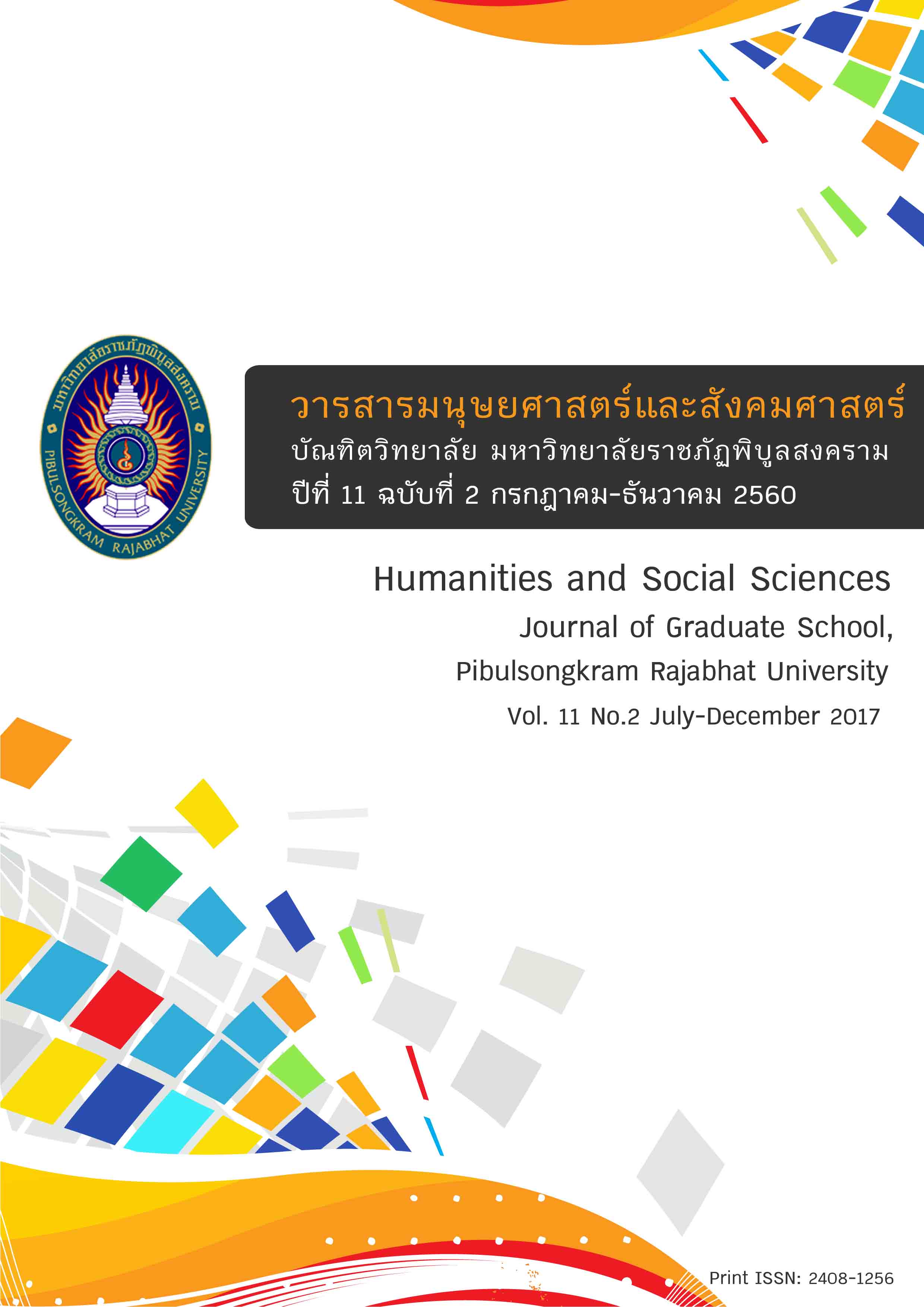The Development of a Contemplative Education Learning Model for Mainstreaming Schools
Keywords:
The Development of a Learning Model, Contemplative Education, Mainstreaming SchoolsAbstract
การวิจัยครั้งนี้มีวัตถุประสงค์เพื่อสร้างและศึกษาผลการใช้รูปแบบการจัดการเรียนรู้ตามแนวคิดจิตตปัญญาศึกษา สำหรับโรงเรียนที่จัดการศึกษาแบบเรียนร่วม โดยมีการศึกษาสภาพการดำเนินงานการจัดการเรียนร่วม สร้างและศึกษาผลการใช้รูปแบบ ทั้งนี้ได้กำหนดแบบแผนการวิจัยเป็นการทดลองหนึ่งกลุ่มเปรียบเทียบก่อนและหลังการใช้รูปแบบ กลุ่มเป้าหมายในการศึกษาคือผู้บริหารและครูโรงเรียนบ้านป่าสัก (ทศพลอนุสรณ์) สังกัดสำนักงานเขตพื้นที่การศึกษาประถมศึกษา พิษณุโลก เขต 2 จำนวน 22 คน ผลการวิจัย มีดังนี้
- การสร้างรูปแบบการจัดการเรียนรู้ตามแนวคิดจิตตปัญญาศึกษา สำหรับโรงเรียนที่จัดการศึกษาแบบเรียนร่วม พบว่า 1) สภาพการดำเนินงานการจัดการเรียนร่วม โดยการสัมภาษณ์ ผู้บริหาร ครูผู้สอนทั่วไป และครูการศึกษาพิเศษ จากโรงเรียนที่จัดการศึกษาแบบเรียนร่วมจำนวน 3 โรงเรียน พบว่าสภาพการดำเนินงานการจัดการเรียนร่วมของโรงเรียนโดยภาพรวม ได้รับงบประมาณและสิ่งสนับสนุนตามโครงการการจัดการเรียนร่วมจากเขตพื้นที่การศึกษา มีการพัฒนาและใช้หลักสูตรการเรียนรู้เหมือนกับเด็กปกติ และเห็นว่าครูคือบุคคลสำคัญในการดูแลให้ความรักความเมตตาต่อผู้เรียน ครูต้องมีความรู้ในหลักของจิตวิทยา แต่ครูยังไม่เคยได้รับการพัฒนาให้มีความรู้เกี่ยวกับเทคนิคหรือวิธีการสอนใหม่ๆ ที่เฉพาะสำหรับโรงเรียนที่จัดการศึกษาแบบเรียนร่วมเลย โดยผู้บริหารให้ข้อสรุปว่า “เทคโนโลยีในปัจจุบันก้าวหน้ามากก็จริง แต่เทคโนโลยียังไม่สามารถแทนครูได้”
2) รูปแบบการจัดการเรียนรู้ตามแนวคิดจิตตปัญญาศึกษาสำหรับโรงเรียนที่จัดการศึกษาแบบเรียนร่วมมีลักษณะสำคัญ 4 ขั้นตอน คือ ขั้นสร้างความตระหนักรู้ ขั้นน้อมใจสู่การพัฒนา ขั้นมุ่งหน้าลงมือปฏิบัติ และขั้นเกิดผลชัดจิตตปัญญา มีค่าดัชนีความสอดคล้องของรูปแบบตามมาตรฐานการประเมินในภาพรวมเท่ากับ 0.75 และ
เมื่อพิจารณารายด้านเรียงลำดับจากมากไปน้อย พบว่าด้านความแม่นยำเท่ากับ 0.79 ด้านความเหมาะสมเท่ากับ 0.78 ด้านความเป็นไปได้เท่ากับ 0.78 และด้านการใช้ประโยชน์ เท่ากับ 0.68 - การศึกษาผลการใช้รูปแบบการจัดการเรียนรู้ฯ มีดังนี้ 1) ผลการนิเทศติดตามระหว่างการใช้รูปแบบพบว่าหลักการสอนตามแนวคิดจิตตปัญญาศึกษาที่ครูนำมาใช้มากที่สุดคือหลักความรักความเมตตา รองลงมา คือหลักการพิจารณาอย่างใคร่ครวญ กิจกรรมการเรียนรู้ตามแนวคิดจิตตปัญญาศึกษาที่ครูนำมาใช้มากที่สุด คือ การสร้างความสงบนิ่งด้วยสมาธิ รองลงมา คือ สุนทรียสนทนา 2) ผลการสะท้อนคิดของผู้บริหารและครูหลังใช้รูปแบบ พบว่าครูมีความเข้าใจในการจัดการเรียนรู้ตามแนวคิดจิตตปัญญาศึกษา พึงพอใจในรูปแบบเพราะช่วยให้เข้าใจตนเอง เข้าใจเพื่อนร่วมงาน รักและสามัคคีกันมากขึ้น โดยระบุว่าในห้วงเวลาที่ผ่านมาไม่เคยมีกิจกรรม
ที่ทำให้เรารักและเข้าใจกันเช่นนี้มาก่อน และทุกคนมีความเห็นตรงกันในเรื่องการให้ความสำคัญในการดูแลและให้ความรักและความเมตตากับผู้เรียนทั้งเด็กปกติและเด็กเรียนร่วมมากขึ้น ชื่นชอบในรูปแบบการจัดการเรียนรู้ตามแนวคิดจิตตปัญญาศึกษา นอกจากนี้ยังมีข้อเสนอแนะว่าควรมีการนิเทศติดตามเพื่อหนุนเสริมการดำเนินงานอย่างต่อเนื่องจึงจะเกิดประสิทธิผลที่ดี 3) ผลการเปรียบเทียบศักยภาพของครูในการจัดการเรียนรู้ตามแนวคิดจิตตปัญญาศึกษา พบว่าครูมีศักยภาพในการจัดการเรียนรู้หลังการใช้รูปแบบสูงกว่าก่อนใช้รูปแบบอย่าง
มีนัยสำคัญทางสถิติ (p < 0.05) 4) ผลการประเมินประสิทธิภาพของรูปแบบ พบว่าภาพรวมประสิทธิภาพของรูปแบบอยู่ในระดับมาก (= 4.41, S.D. = 0.67) และเมื่อพิจารณารายด้าน พบว่าอยู่ในระดับมากทุกรายการ โดยเรียงลำดับจากมากไปน้อย ดังนี้ ด้านความเหมาะสม (
= 4.47, S.D. = 0.72) ด้านความเป็นไปได้ (
= 4.40, S.D. = 0.70) ด้านการใช้ประโยชน์ (
= 4.39, S.D. = 0.56) ด้านความแม่นยำ (
= 4.38, S.D. = 0.60)
The purposes of this research were to construct a Contemplative Education Learning model for mainstreaming schools and to study the results of implementing the model. The experimental design was one group Pretest-Posttest design with a school director and 21 teachers from Baan Pasuk School under the Office of Phitsanulok Primary Educational Service Area 3. The findings were as follows:
- Results from the development of an inclusive education learning model for mainstreaming schools indicated that 1) in general, working conditions in the schools, as interviewed by school director, general education teachers, and special education teachers, schools were allocated budgets and supported from the Office of Phitsanulok Primary Educational Service Area 3 while developing and using the same curriculum as provided for students without disabilities. Moreover, even teachers were seen as important personnel in taking care of their students; they were found not to be trained to be acknowledgeable for new specific teaching techniques required for teaching in mainstreaming schools. School directors concluded that “even today technology is advanced, it cannot be replaced the teachers”, 2) the inclusive education learning model for mainstreaming schools consisted of 4 critical stages including raising awareness, gearing to development, implementing immediately, and leading to contemplative results. The overall index of model consistency according to the standards was at 0.75, accuracy standard was at 0.79, propriety standard was at 0.79, and feasibility standard was at 0.78.
- Results of implementing the inclusive education learning model for mainstreaming schools indicated that 1) the most frequent employed contemplative education principle was compassion followed by the principle of contemplation. The most frequent employed contemplative learning activity was meditation followed by dialogue. 2) Reflection by the school director and teachers indicated that teachers felt more acknowledgeable on employing contemplative education activities to use in their classrooms. They were satisfied with the model since it helped them understand themselves and their colleagues inside the working place. They felt love and united indicating that they had never found such activity to help them love and understand each other before. All teachers agreed that they should pay more attention to both students with and without disabilities at the same level. In addition, teachers suggested that continuing supervision and empowerment should be organized for better effectiveness. 3) Comparison of teacher potential after employing the contemplative education learning model indicated that teachers were more capable of organizing learning activities at a significant level (p < 0.05). 4) An evaluation of the inclusive education learning model showed the overall mean scores at a high level (
= 4.41, S.D. = 0.67). When each aspect was examined, propriety, feasibility, utility, and accuracy scores were found to be high (
= 4.47, S.D. = 0.72), (
= 4.40, S.D. = 0.70), (
= 4.39, S.D. = 0.56), (
= 4.38, S.D. = 0.60)
Downloads
Published
How to Cite
Issue
Section
License
บทความหรือข้อคิดเห็นใดใดที่ปรากฏในวารสารมนุษยศาสตร์และสังคมศาสตร์ มหาวิทยาลัยราชภัฏพิบูลสงครามเป็นวรรณกรรมของผู้เขียน ซึ่งบรรณาธิการไม่จำเป็นต้องเห็นด้วย บทความที่ได้รับการตีพิมพ์เป็นลิขสิทธิ์ของวารสารมนุษยศาสตร์และสังคมศาสตร์ มหาวิทยาลัยราชภัฏพิบูลสงคราม







